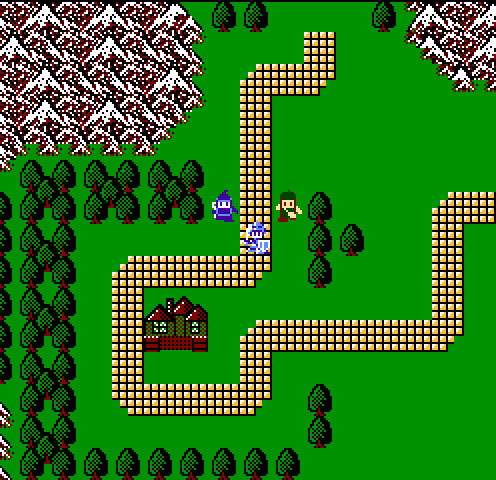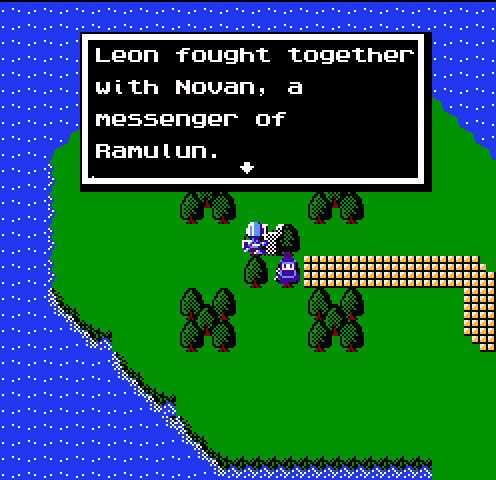Minelvaton Roads
the motif of roads recurs throughout minelvaton saga (1987). “minelvaton” is the name of the greater world that encompasses the game's isolated setting of “southern ofelia”. but “minelva” itself is the name of a road, a dimensional corridor walked by the player that connects two distant “time gates”. the minelva road connects kingdom to kingdom, the mortal realm to the home of the gods, and southern ofelia to the other lands of minelvaton.

on a long, straight road you can see near things and far things at the same time. as you tread down it, things you saw in the distance before grow closer and closer to you until they are present, then pass out of sight behind you. meanwhile, new things come into view over the horizon. like dragon quest 1 and (especially) 2, minelvaton saga is a game about assembling clues, that is, becoming aware of things that will be useful down the road. ordinary townsfolk offer clues about the situation at hand, things that are relevant to my journey now or will become relevant shortly; while minstrels and stone monuments tell me of history and myth that stand worlds apart from my current concerns. i may not know their relevance now, but it will become clearer later. the townspeople’s clues lead me down the road one step at a time until i discover i’m in a new position: now the townspeople have new clues, their concerns shifted a step toward whatever the minstrels were talking about before, and the minstrels’ new stories reach a little farther back in time. as i follow the road of the game backward through the ages, those far-off bumps on the horizon come into clearer view, and before i know it they’re right in front of me: i’m liberating my hometown from monsters, i’m retracing the legendary hero’s footsteps, i’m meeting with the gods themselves.

roads are present in a much more material way too, visible and walkable on the overworld. fewer rpgs than i would expect show roads on the world map, and fewer still ascribe any meaning or function to them. minelvaton saga’s land roads are safe from random encounters, which speeds up journeys considerably, if indirectly. they often gesture towards locations of note, even with twists or gaps. more often, they form parts of larger, implicit roads across the world map; southern ofelia is huge and its walkable geography is elaborate; much of the game is spent learning how to get between point A and point B and much more still is spent retreading these paths. as i learn how the jigsaw of the world fits together, i find the threads that lead me most directly through the tangle. dungeons, which are almost always mazes, contain invisible roads in much the same way. the shortest path that winds between dead ends and unwanted treasures matters all the more because so many dungeons are revisited, as no dungeon gives away all its secrets on the first visit.
as i march deeper into the game, even the dungeons themselves become roads. starting arguably with the ice palace cave and continuing over the game’s second half, minelvaton saga asserts with increasing force that dungeons are not only repositories for trinkets, but also, simultaneously, pathways to other places. the temple of gula leads to rabant castle, which leads via secret passage to the gorgon’s maze, and that’s not even the end of it. the road from arkasas (my royal seat and eventually a sort of central hub town) to the final boss’s chamber spans a linear sequence of 8 dungeons, each of which is a maze through which the most direct route can only be discovered through deliberate probing, with one singular, diversion-laden highway secretly snaking through the whole world. the road runs through everything.

which is sort of obvious in retrospect. that’s where i see meaning in the road motif - it crystallizes something already present in the fabric of the genre, but yet unstated. symbolically, roads are no less present in dragon quest 1 and 2, which are so much about navigating the mazes of the overworld and dungeons and in doing so finding the most direct and reliable ways of traversing a space i'll visit multiple times. minelvaton saga’s roads tell us that when we walk from rimuldar through charlock castle to face the dragonlord, or when we dive into the sea cave for the 5th time to in hopes of finally, this time, surviving to its deepest point, underneath the flashy, fussy surface of combat and resource management, the fundamental process is about movement - navigation. this is the project of the minelvaton saga, taking this little axiom of rpg structure and magnifying it, little by little, like a distant mountain growing against the horizon until it’s right in front of us, and now it's all we can see.
